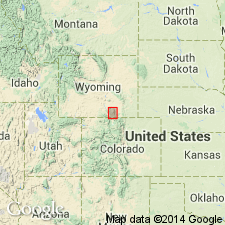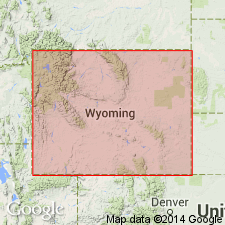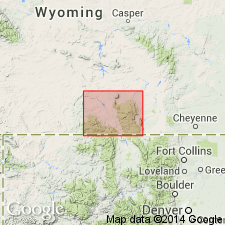
- Usage in publication:
-
- Baggot Rocks granite
- Modifications:
-
- Original reference
- Geochronologic dating
- Dominant lithology:
-
- Granite
- AAPG geologic province:
-
- Northern Rocky Mountain region
Summary:
Pg. 1763-1767. Baggot Rocks Granite. Massive to foliated granite cut by diabase dikes and pegmatite. Has the form of a phacolith, shows gradational and cross-cutting relationships to gneiss country rock. Age is Precambrian X (2340 +/-50 Ma, based on seven whole-rock Rb/Sr and Zr samples).
Type locality: Baggot Rocks, in T. 15 N., R. 83 W., Carbon Co., south-central WY.
Source: US geologic names lexicon (USGS Bull. 1520, p. 16); supplemental information from GNU records (USGS DDS-6; Denver GNULEX).

- Usage in publication:
-
- Baggot Rocks Granite
- Modifications:
-
- Age modified
- Geochronologic dating
- AAPG geologic province:
-
- Northern Rocky Mountain region
Summary:
Applied in this report on the Sierra Madre Range, Carbon Co, WY, Northern Rocky Mountain region, to mildly foliated to massive quartz monzonite and granite along east flank of Sierra Madre. Has gradational to sharp cross-cutting contacts with the older Archean augen and quartz-biotite gneiss. Forms prominent rounded outcrops which contrast with the subdued topography of the gneiss. Has massive, fine-grained phases that discordantly intrude massive coarse grained phases. Is typically 30 percent microcline, 30 percent oligoclase, 35 percent quartz +/-biotite +/-muscovite +/-epidote. Lithology and chemistry described in detail. Geologic map. Textural and structural relations are complex. Massive fine-grained phases discordantly intrude massive, coarse-grained phases which are concordant with the older augen gneiss. Granite intruded into mafic dikes which in turn cross-cut granite. Chemical data. Was probably an intrusive magma with gradational contacts or a mobilized component of the metasomatic microcline augen gneiss. Five whole rock and microcline samples define an isochron of 2,560 +/-100 m.y. Age modified to Archean.
Source: GNU records (USGS DDS-6; Denver GNULEX).

- Usage in publication:
-
- Baggot Rocks Granite*
- Modifications:
-
- Age modified
- Geochronologic dating
- AAPG geologic province:
-
- Northern Rocky Mountain region
Summary:
Type locality stated to be Baggot Rocks, T15N, R83W, Carbon Co, WY in the Northern Rocky Mountain region. Is concordant in structure with enclosing felsic gneiss; locally has a gradational contact with felsic gneiss; locally massive phases cut quartzo-feldspathic gneiss showing that the granite is younger than the gneiss or has been mobilized preferentially in a later event. Intrudes Overland Creek Gneiss and Rock Mountain Conglomerate in the Medicine Bow Mountains. Occurs as pink granitic bodies in the extreme western Medicine Bow Mountains. Ranges in composition from granite, granodiorite, quartz monzodiorite, tonalite, quartz-alkali-feldspar granite, to alkali-feldspar granite. The bodies may differ in age. Is part of a granite-forming event at about 2,450 Ma. Is Late Archean age. Was overprinted by Proterozoic metamorphic or thermal episode. Geologic map; chemical analyses. Early Proterozoic age (rather than Archean as in earlier reports) suggested. Dated as 2,430 +/-5 Ma by U/Pb zircon method.
Source: GNU records (USGS DDS-6; Denver GNULEX).
For more information, please contact Nancy Stamm, Geologic Names Committee Secretary.
Asterisk (*) indicates published by U.S. Geological Survey authors.
"No current usage" (†) implies that a name has been abandoned or has fallen into disuse. Former usage and, if known, replacement name given in parentheses ( ).
Slash (/) indicates name conflicts with nomenclatural guidelines (CSN, 1933; ACSN, 1961, 1970; NACSN, 1983, 2005, 2021). May be explained within brackets ([ ]).

